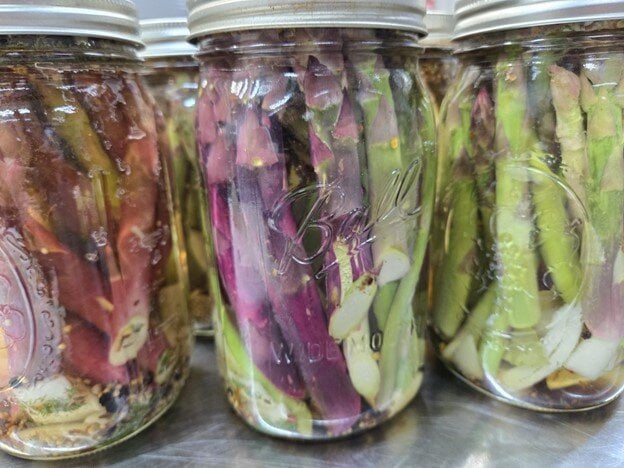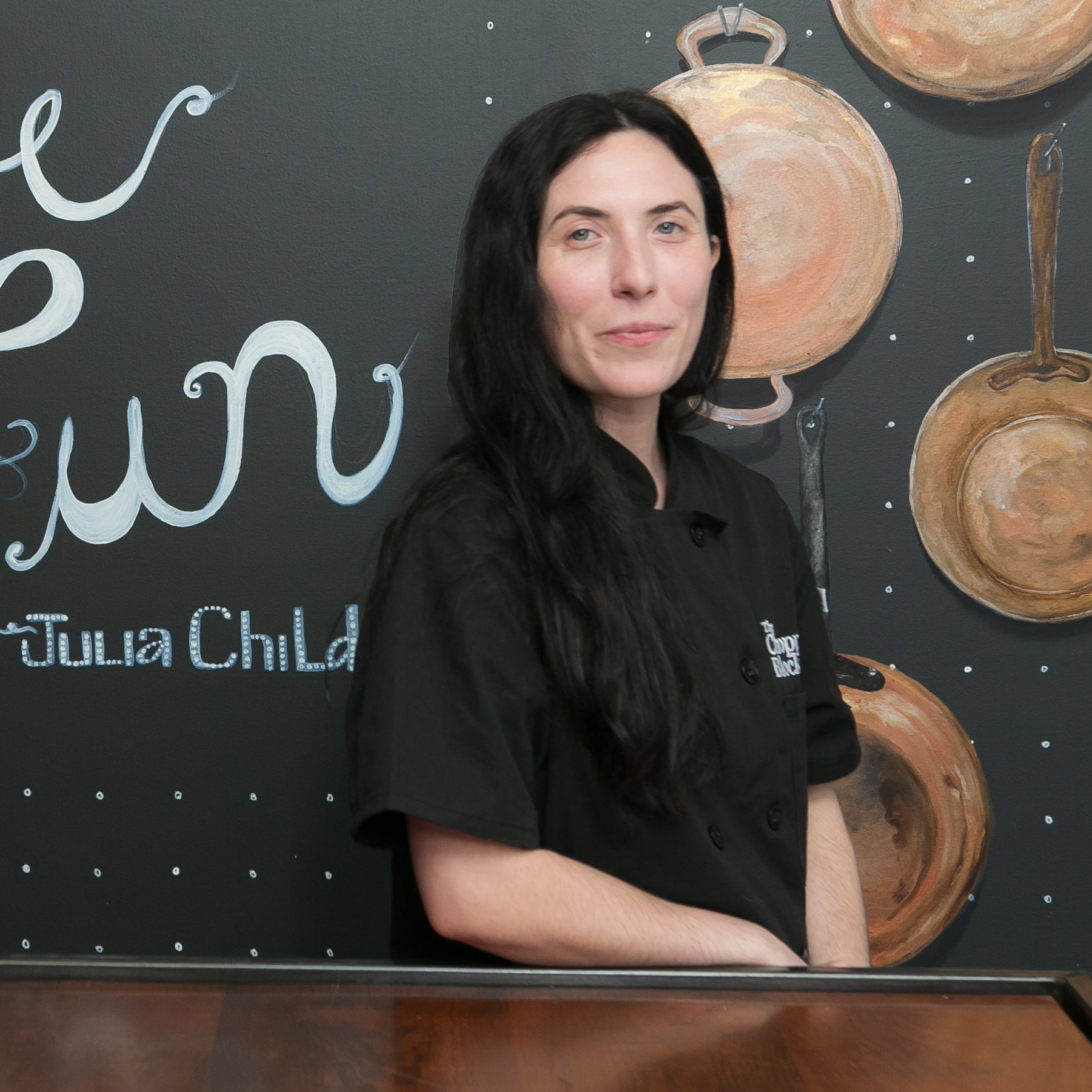We are in peak asparagus season! When you have an asparagus patch in your garden, you are never short of these amazing vegetables through the spring and summer. Asparagus is a perennial and one of the easiest vegetables to grow. You plant them once and they come back better year after year. You can find asparagus at the store year round, but the best time to harvest and eat them is in the spring months. It's one of the first vegetables of the year, which makes it even more exciting.
 When you have an abundance of vegetables, it's hard to see anything go to waste. I am a person that loves vegetables in their natural state, raw. I also love pickled vegetables, so I often find myself pickling everything. It preserves excess produce, and in my opinion, makes for an even better snacking vegetable. Quick pickling asparagus turns your simple asparagus into a tangy addictive accompaniment to so many things. I like to eat these straight out of the jar, but serve them as a side, in a salad, on a charcuterie board, in a Bloody Mary, or even on a sandwich.
When you have an abundance of vegetables, it's hard to see anything go to waste. I am a person that loves vegetables in their natural state, raw. I also love pickled vegetables, so I often find myself pickling everything. It preserves excess produce, and in my opinion, makes for an even better snacking vegetable. Quick pickling asparagus turns your simple asparagus into a tangy addictive accompaniment to so many things. I like to eat these straight out of the jar, but serve them as a side, in a salad, on a charcuterie board, in a Bloody Mary, or even on a sandwich.
 There are three main varieties of asparagus - green, purple, and white. Each having their own unique characteristics but very similar in flavor. All asparagus has a grassy, sweet flavor with an earthy bitterness.
There are three main varieties of asparagus - green, purple, and white. Each having their own unique characteristics but very similar in flavor. All asparagus has a grassy, sweet flavor with an earthy bitterness.


- Green: The most commonly found asparagus, green asparagus are usually thinner than other types of asparagus. They get their green color from the chlorophyll necessary for photosynthesis.
- White: White asparagus lack color because they grow in the dark, preventing photosynthesis. Despite their white color, the flavor is similar to green asparagus.
- Purple: Purple asparagus is the sweetest type. It gets its purple color from high levels of anthocyanins.
How to Pickle Asparagus
Before pickling, make sure to sanitize your Mason jars. Boil the jars for a couple of minutes just to ensure there is no bacteria in them. Alternatively, you can also sterilize your jars in the oven.
The first thing you need to do is trim the asparagus. Snap the bottoms off or cut them to appropriately fit the jar you are using. Thoroughly wash the asparagus and set aside.

Now it’s time to make the brine. There are a lot of ways to pickle, but my favorite way is quick pickling or cold pickling. It’s fast and it allows the vegetables to stay crisp and fresh. Adding a lot of heat starts to break down the vegetables and they start to lose their beautiful colors. Heat the vinegar, water, salt, and sugar over medium heat, stirring until the salt and sugar dissolves.
 In a Mason jar, place the asparagus, garlic, onion, dill, red pepper flakes, bay leaf, peppercorns, and mustard seeds. Pour the hot brine over the asparagus so it is submerged and allow it to cool at room temperature. Place the lid on and refrigerate. In the pickling brine, the asparagus will keep for well up to a month.
In a Mason jar, place the asparagus, garlic, onion, dill, red pepper flakes, bay leaf, peppercorns, and mustard seeds. Pour the hot brine over the asparagus so it is submerged and allow it to cool at room temperature. Place the lid on and refrigerate. In the pickling brine, the asparagus will keep for well up to a month.



 You can absolutely eat these right away, but they are best after sitting in the brine for a couple days to really develop the flavors.
You can absolutely eat these right away, but they are best after sitting in the brine for a couple days to really develop the flavors.

Pickled Asparagus
Scroll down for a printable version of this recipe
Yield: 2 (32 oz) quart Mason jars
Prep time: 15 minutes
Cook time: 5 minutes
Total time: 20 minutes
1 1/2 pounds fresh asparagus
3 garlic cloves per jar - smashed and peeled
1/8 - 1/4 cup sliced onion per jar
2 sprigs fresh dill or 1 teaspoon dried per jar
1/2 teaspoon black peppercorns per jar
1 teaspoon red pepper flakes per jar
1 teaspoon mustard seed per jar
1 bay leaf per jar
For the brine:
2 cups water
2 cups white vinegar
1 Tablespoon Kosher salt
1/2 - 1 teaspoon sugar
- Wash and trim the asparagus. Snap or trim the ends to fit the jar.
- Make the brine. In a small pot, add water, vinegar, salt, and sugar. Cook over medium heat. Stir until the salt and sugar has completely dissolved.
- Place asparagus, garlic, onions, peppercorns, dill, red pepper flakes, bay leaf, and mustard seed in the jar.
- Pour hot brine over asparagus submerging the contents but leaving a 1/2-inch head space on top.
- Allow to cool at room temperature. Once cooled, put the lid on the jar and refrigerate.
- Keep for up to a month in the refrigerator.
This quick pickle recipe is a universal brine for pretty much any vegetable. If you want it to be spicier, add more red pepper flakes or garlic. If you want it to be sweeter, add more sugar. Any basic vinegar will work in this recipe, other options are apple cider vinegar, red wine vinegar, white wine vinegar or rice wine vinegar. They will have a slightly different flavor but all are good options. Play around with the flavors, add different spices, herbs, vegetables, or different vinegars. Really make this to your liking!
I hope you enjoyed this recipe! If you did and want to learn more about seasonal vegetables, check out The Chopping Block's upcoming Hands-On Spring Garden Spotlight class coming up on Tuesday, May 28 at 6pm.

Pickled Asparagus
Ingredients
- 1 1/2 pounds fresh asparagus
- 3 garlic cloves per jar - smashed and peeled
- 1/8 - 1/4 cup sliced onion per jar
- 2 sprigs fresh dill or 1 teaspoon dried per jar
- 1/2 teaspoon black peppercorns per jar
- 1 teaspoon red pepper flakes per jar
- 1 teaspoon mustard seed per jar
- 1 bay leaf per jar
- 2 cups water
- 2 cups white vinegar
- 1 Tablespoon Kosher salt
- 1/2 - 1 teaspoon sugar
Instructions
- Wash and trim the asparagus. Snap or trim the ends to fit the jar.
- Make the brine. In a small pot, add water, vinegar, salt, and sugar. Cook over medium heat. Stir until the salt and sugar has completely dissolved.
- Place asparagus, garlic, onions, peppercorns, dill, red pepper flakes, bay leaf, and mustard seed in the jar.
- Pour hot brine over asparagus submerging the contents but leaving a 1/2-inch head space on top.
- Allow to cool at room temperature. Once cooled, put the lid on the jar and refrigerate.
- Keep for up to a month in the refrigerator.











